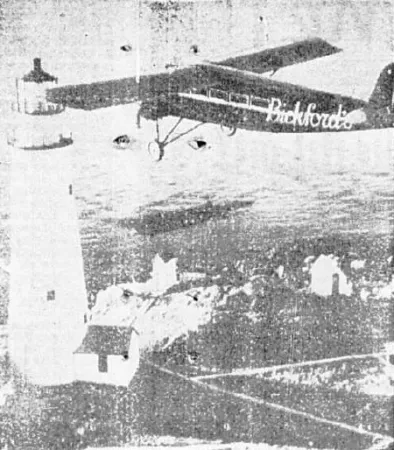The Flying Santa Claus, William H. Wincapaw

Happy New Year, my reading friend. Our first 2018 story is a heart warming endeavour that began in 1929. With your permission, yours truly would like to use a source other than a magazine found on the mobile stacks of the amazing library of the Canada Aviation and Space Museum, in Ottawa, Ontario.
Our photo thus comes from the 3 January 1938 issue of L’Illustration nouvelle, and that’s a problem. You see, my reading friend, the editor of this populist illustrated daily published in Montréal, Québec, was none other than Adrien Arcand, a leading figure of Canada’s extreme right and leader of the Parti national social chrétien. Was L’Illustration nouvelle a national socialist newspaper, like the party led by Arcand, you ask? No, it was not. This tabloid newspaper, the first to be published in Montréal if you must know, strongly supported the Premier of Québec, the very conservative Maurice Le Noblet Duplessis. Still, can on use a source tainted by Arcand’s presence when writing an article for this blog / bulletin / thingee? In this case, yours truly believes / hopes it can be done.
A pilot since the First World War, if not earlier, William H. Wincapaw (1885-1947) was well known for the many mercy flights he had made to help ill or injured people who lived on the islands of Penobscot Bay, in Maine. The Curtiss Flying Service Incorporated seaplane pilot had often depended on the dedicated work of lighthouse keepers to stay on course. On 25 December 1929, he dropped packages of gifts on the isolated islands where these men lived with their families. Wincapaw was so overwhelmed by their messages of thanks that he renewed the experience from 1930 onward. Christmas Day after Christmas Day, with few exceptions, he dropped packages of gifts on isolated lighthouses and settlements located along the shores of New England. Wincapaw gradually became known as the Santa of the lighthouses, or the Flying Santa Claus. Indeed, he began to dress the part.
As the cost of the program increased, Wincapaw had to look for sponsors. One of these was Bickford’s, Incorporated. This restaurant chain seemingly owned a Stinson SM-6000 Airliner that Wincapaw flew on at least one occasion. This medium size trimotor is the airplane you can see in the photo above. Another sponsor was La Touraine Coffee Company, a firm owned by W.S. Quimby Company, an importer and roaster of coffee (and tea?). This particular cooperation was to continue for decades to come. Sadly, Wincapaw himself died in July 1947 in a crash that had nothing to do with his flying Santa Claus activities.
Over the following years, numerous people, including this remarkable man’s son, William “Bill” Wincapaw, Jr., piloted various types of airplanes and, especially, helicopters to deliver the packages of gifts. One of the airplanes used after the Second World War was a Cessna T-50 operated by a small air transport company. You may be interested, or not, my reading friend, to read that the collection of the Canada Aviation and Space Museum includes a nearly identical machine, a Cessna Crane advanced trainer flown by the Royal Canadian Air Force, currently in storage.
You may also be interested to read that the first helicopter used to deliver packages of gifts, in December 1946, was a Sikorsky S-51 owned by Helicopter Air Transport, Incorporated, a company mentioned in an August issue of this blog / bulletin / thingee. And yes, my reading friend, the collection of the Canada Aviation and Space Museum does include a helicopter of this type. Small world, isn’t it?
As of 2017, the Flying Santa organisation was still going strong. I wish it well.

More Stories by



















![A block of photographs showing some of the people involved in the bombing of beluga whales in the estuary and gulf of the St. Lawrence River. Anon., “La chasse aux marsouins [sic]. » Le Devoir, 15 August 1929, 6.](/sites/default/files/styles/thumbnail_7/public/2024-09/Le%20Devoir%2015%20aout%201929%20page%206.jpg?h=584f1d27&itok=TppdLItg)












































































































































































































![Peter Müller at the controls [sic] of the Pedroplan, Berlin, Germany, March 1931. Anon., “Cologne contre Marseille – Le mystère du ‘Pédroplan.’ [sic]” Les Ailes, 2 April 1931, 14.](/sites/default/files/styles/thumbnail_7/public/2021-04/Les%20Ailes%202%20avril%201931%20version%20big.jpg?h=eafd0ed4&itok=WnBZ5gMf)












![One of the first de Havilland Canada Chipmunk imported to the United Kingdom. Anon., “De Havilland [Canada] DHC-1 ‘Chipmunk.’” Aviation Magazine, 1 January 1951, cover.](/sites/default/files/styles/thumbnail_7/public/2021-01/Aviation%20magazine%201er%20janvier%201951%20version%202.jpg?h=2f876e0f&itok=DM4JHe5C)




























































































